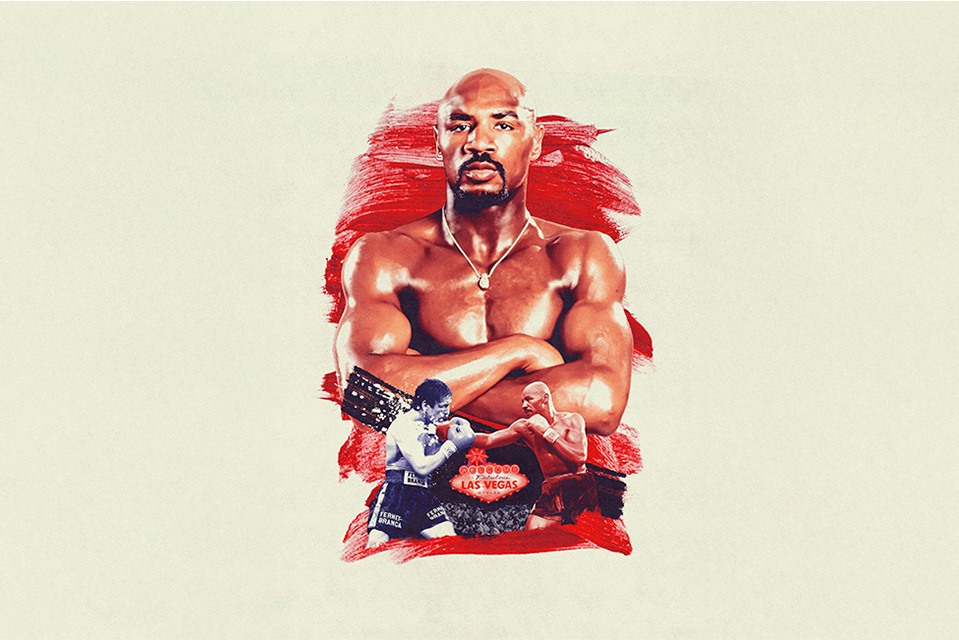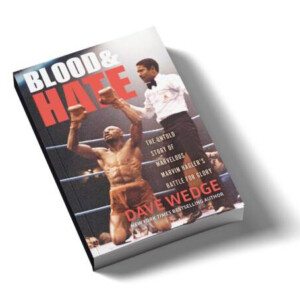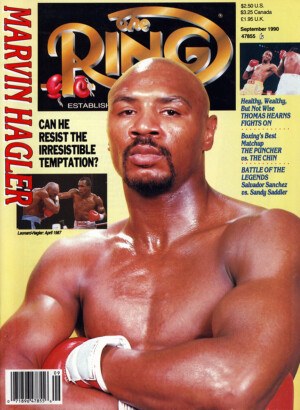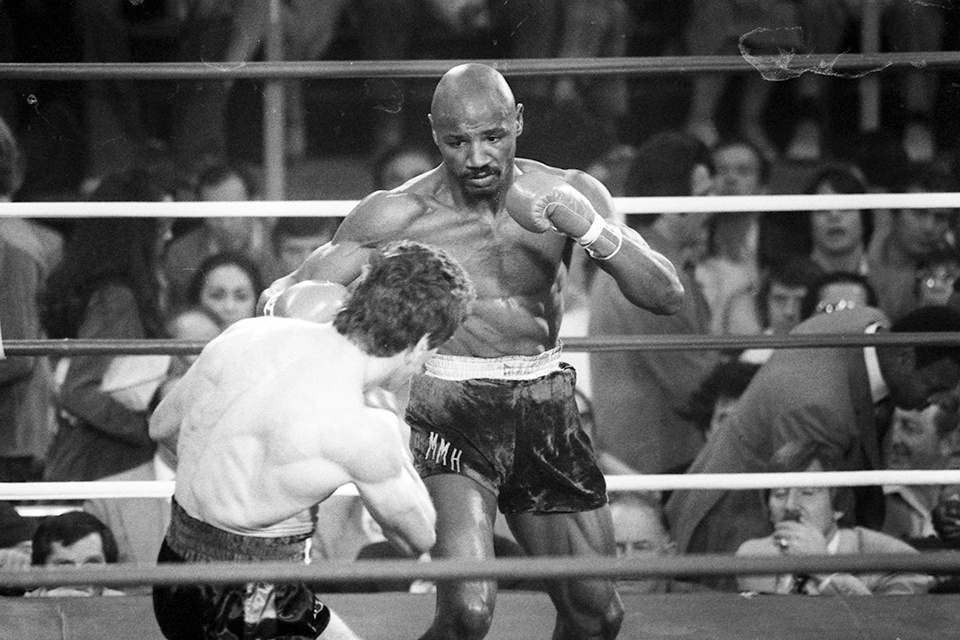How Ted Kennedy and Tip O’Neill Got Boxing Legend Marvin Hagler a Title Shot
Brockton’s “Marvelous Marvin” battled the sport’s gatekeepers with unexpected allies by his side.

Photo Illustration by Benjamen Purvis / Images from Getty
This story is an excerpt from Dave Wedge’s Blood & Hate: The Untold Story of Marvelous Marvin Hagler’s Battle for Glory, out from Hamilcar now.
In the late 1970S, U.S. Senator Ted Kennedy and House Speaker Tip O’Neill were two of the most powerful people in national politics, busy shaking hands and making deals on Capitol Hill. They were also, at the same time, using their vast influence for an unlikely cause: advocating for a talented boxer out of Brockton named Marvin Hagler.
At that point, Hagler had already fought his way through dozens of brutal bouts in pursuit of a world title shot. But the sport’s kingmakers had systematically denied him his chance.
Kennedy first met Hagler while he was training in Provincetown, not far from the infamous Kennedy compound, and became a regular at his training sessions. In turn, Hagler supported Kennedy’s campaigns, appearing at parades and fundraisers. O’Neill, a Cambridge native who’d grown up loving boxing, deeply respected both the sport and Hagler’s dedication to it.
At the time, both lawmakers were enraged by the Ring Magazine scandal, which involved fighters’ records being fraudulently inflated to secure spots in the 1977 United States Boxing Championships Series. As it turned out, superior boxers who wouldn’t sign with tournament mastermind and notorious fight promoter Don King, like Hagler, were excluded, while most of the fighters with doctored records were under contract to him.
Shortly after news of the scandal erupted, Bob Arum, another of the world’s biggest fight promoters at the time, received two letters: one from Kennedy and another from O’Neill. “Both letters said the same thing,” Arum said. “That it was an outrage their constituent Marvin Hagler wasn’t being given an opportunity to fight for the middleweight championship. They told me that if I didn’t arrange sooner rather than later for Hagler to fight for the championship, there would be a joint committee investigation into boxing.”“My ass would go before a joint committee,” Arum added. “I obviously realized I didn’t need this problem.”
As the disgraced tournament rocked the sport, pressure mounted on Arum to give Hagler a shot, driven by a host of Washington heavyweights. Beyond the letters from O’Neill and Kennedy, Hagler’s attorney, Steve Wainwright, tapped two politicians: U.S. Senator Paul Tsongas of Lowell and U.S. Representative Edward Beard of Rhode Island, both avid boxing fans. Beard fired off a letter to World Boxing Council (WBC) President José Sulaimán, suggesting that the organization was stalling in giving Hagler his chance and hinting at a congressional investigation into boxing, the L.A. Times reported at the time.
“Politicians love a fight,” Hagler’s manager, Pat Petronelli, later told the L.A. Times, “and they really warmed up to this one.”
The sporting press was also starting to pick up Hagler’s cause. In late 1977, the Associated Press dubbed him the “new Rocky” Marciano—the legendary boxer who had fought out of Brockton in the ’40s and ’50s. Everyone in and around the sport—the Petronelli brothers (Pat and his brother Goody, also Hagler’s trainer), Arum, Wainwright, King, and especially the people of the City of Champions—could see that Hagler was the heir to Marciano’s throne. He would never be Marciano; no one could replace an undefeated legend. But he carried that same aura of invincibility and underdog mentality that made you root for him.
 Hagler and Marciano were different fighters, but they had the same undeniable, intangible qualities that elevated them above their peers: relentless commitment and heart. Hagler rarely talked about living in Marciano’s shadow but took pride in being from the same city. He respected Marciano’s achievements as much as anyone.
Hagler and Marciano were different fighters, but they had the same undeniable, intangible qualities that elevated them above their peers: relentless commitment and heart. Hagler rarely talked about living in Marciano’s shadow but took pride in being from the same city. He respected Marciano’s achievements as much as anyone.
He and the Petronelli brothers sometimes talked about what made Marciano great. The brothers had been boyhood friends of the late undefeated heavyweight champion, and would remind Hagler that he possessed many of the same qualities that made Marciano great. “If you don’t have a good chin, forget it,” Goody told the Washington Post years later, referencing the physical attribute that helps fighters avoid knockouts. “God supposedly created us all equal. He really didn’t. He created some with chins and some without.”
“I never met Marciano myself,” Hagler also told the Washington Post, “but I feel as though I know the man. I love his techniques about training and how all the odds were against him.” He added that Marciano “put Brockton on the map. It’s my job to keep it there. It’s a beautiful place.”
Goody and Pat could not have been prouder of both of them. But while Marciano got his title shot early in his career, the brothers were still battling to get Hagler his due—after 49 fights. The Ring Magazine scandal ended up working in Hagler’s favor, as many in boxing realized how absurd it was that he’d been blackballed by King, promoter Al Braverman, and their henchmen. “There’s still a lot of politics in boxing,” Hagler told the Associated Press at the time. “It’s who you know. But I’ll get a title shot if I get one break.”
When Hagler was asked about the scandal, he was direct: “I beat four guys King put in that tournament. The ratings don’t mean nothing. It only counts when you’re champion.”

Hagler on the cover of The Ring Magazine. / Photo by The Ring Magazine via Getty Images
Regardless of his title status, in the late 1970s Hagler’s knockouts and growing public persona had the Petronelli brothers fielding calls from promoters, agents, managers, and others who wanted a piece of their young fighter. Offers poured in for Hagler to move to world-class training facilities with state-of-the-art equipment and trainers. Yet despite being one of the top contenders in the world, he continued training at the Petronelli brothers’ Brockton gym, with its yellowing, peeling boxing posters, poor lighting, single rusty shower, and broken clock.
King and others tried to lure Hagler away from the brothers, appealing to Hagler’s then-partner, Bertha, with promises of riches, private jets, and swanky hotels. It nearly worked, as Hagler and Bertha considered leaving for California and starting fresh with new management. “We talked a lot about his fighting career,” Bertha recalled. “We were going to move at one point.”
Hagler went to Goody and Pat to break the news. “I can’t wait any longer,” he said.
“Marvin, you’ve got to keep winning to get a shot,” Bertha recalls Pat telling Hagler. “If you win this [next] one, Marvin, you’ve got it.”
But it was déjà vu for Hagler. He’d dominated in the ring 49 times—often against men who had already had their title shot, some repeatedly. “Every time I won, there was nothing,” Marvin later told Sports Illustrated. “Every day I was out there running, paving the ground, getting knocked around in the gym, keeping sharp, getting ready for that day.”
Goody and Pat begged him to stick it out with them a little longer.
“If we felt as though we couldn’t do it for you, we’d be the first ones to let you find something else,” Goody told Hagler.
Goody and Pat understood Hagler’s struggle deeply. They reminded him of their shared journey—from that first day he walked into the gym with holes in his shoes to this moment, teetering on the brink of superstardom. Hagler wanted to trust them. But also he was watching fighters like Sugar Ray Leonard rake in massive paydays and endorsement deals that were still eluding him.
Sitting with Bertha in their Brockton living room, they weighed the scenarios. Moving to California with their young kids would be difficult. And what if he didn’t have a fight for a year or more? What if he didn’t get a title shot? At least with Goody and Pat, he had a team he could trust.
Hagler, ultimately, believed in the Triangle, or what the three men called their partnership. “So I took my bags back,” Hagler recalled to the press about the situation. “But I was hurt. The rent had to be paid. The kids had to have clothes…. There hasn’t been nobody giving me nothin’.” Regardless, he committed to Brockton and the Pertronellis.
The move paid off. Caving to the threats from the senators and congressmen from Massachusetts, Arum called a meeting in New York in 1979 with Goody and Pat, where he promised Hagler his long-awaited shot at the title.
“I said, ‘Look, I don’t want any problems,’” Arum said.
He promised to put Hagler on the undercard of the Vito Antuofermo-Hugo Corro middleweight championship fight in Monte Carlo in June 1979. “I’ll arrange for him to fight the winner,” Arum told the Petronellis.
Hagler had been preparing for this moment for years. Whether it was Corro—the undefeated champion who hadn’t lost in three years—or Antuofermo—the Brooklyn-trained fighter—Hagler didn’t care. He salivated at the thought of challenging either one for the belt.
Antuofermo and Corro met on Saturday, June 30, 1979, at Chapiteau de l’Espace Fontvieille in Monaco. On the undercard, Hagler faced Norberto Cabrera, an Argentine fighter with a 22–7 record. At the time, Hagler was the number-one middleweight contender in the world.
Before the fight, Hagler used the press to taunt and shame the entire middleweight division. “Why don’t they fight me?” he asked reporters.
Cabrera had no business being in the ring with Hagler. In fact, he punished Cabrera over eight rounds before Cabrera’s corner threw in the towel. The crowd, including a strong American contingent, cheered wildly for Hagler after the victory, chanting “world champ!” over and over.
In his post-fight interview, Hagler kept up the bravado. Asked who he preferred to fight for the title, Antuofermo or Corro, Hagler said, “It wouldn’t take me longer with either of them than it did with Cabrera.”
After the fight, Cabrera was stunned at the punishment he took. “Hagler lands his blows faster than anything I’ve ever seen,” he told the press. “Where I was expecting two blows, I’d get three or four…. He would beat Corro or Antuofermo in less than seven rounds.”
Antuofermo took care of business, beating Corro in a split decision over 15 rounds to earn the championship title. Corro and Antuofermo reportedly both watched in awe at Hagler’s easy destruction of Cabrera. “People say that when Antuofermo and Corro fought each other, each of them was happy for the other guy to win. They didn’t want to fight Marvin,” Arum told the Boston Herald in 2020.
Soon after, Arum was true to his word and scheduled a title fight between Hagler and Antuofermo at Caesars Palace in Vegas. The bout was set for just a few months later, on November 30, 1979.
Hagler had waited his whole life for the moment. “I see myself with my hands in the air and Vito down on his back,” he told the press before the fight. “I hear the referee say, ‘the new middleweight champion: Marvelous Marvin Hagler.”
Hagler had waited his whole life for the moment, and reveled in it. He told the press before the fight: “I see myself with my hands in the air and Vito down on his back.… I hear the referee say, ‘The new middleweight champion: Marvelous Marvin Hagler.’”
Hagler even carried around a fly swatter and told the press, “I’m gonna swat him down like a fly. I call him ‘Vito the Mosquito.’” It was a nickname that stuck.
Tip O’Neill was among the star-studded crowd at Caesars rooting for Hagler, whose popularity had now grown far beyond New England. In Europe, he was already seen by many as the true middleweight champ. He was an emerging superstar, and with the likes of O’Neill ringside, the world saw Hagler had the backing of one of the most powerful figures in Washington, DC. King, Arum, and every other trainer and promoter in the world was on notice.
While it was a title fight, Hagler and Antuofermo were not the main event. That distinction went to Sugar Ray Leonard, who took the WBC welterweight title from Wilfred Benítez with a TKO.

Hagler hrows a right punch to Vito Antuofermo during the fight at Caesars Palace on November 30,1979 in Las Vegas, Nevada. / Photo by: The Ring Magazine via Getty Images
In the co-feature to the Leonard-Benítez fight, Hagler and Antuofermo squared off. “Marvin was at his best over the first half of that fight,” said boxing writer Michael Katz in George Kimball’s 2008 book Four Kings. “He was landing combinations, hitting Antuofermo with everything he threw. Only Vito’s chin kept him in that fight.”
Hagler seemed to have controlled the action, and most thought he was in command going into the 12th round. Hagler had never gone the full 15 rounds, but here he was, on boxing’s biggest stage, against the middleweight champion of the world, pushing himself to go the distance.
Antuofermo fought desperately in the late rounds, knowing he was behind. In the final minutes of the bout, Antuofermo caught Hagler with an uppercut that rocked his head back and nearly knocked him down. But Hagler was never hurt, and most in attendance agreed that he had won most rounds and would be crowned the new champion.
After the final bell, referee Mills Lane approached Goody and Pat.
“The referee [said], ‘Step aside, because when I raise Marvin’s hand up, I want them to take a picture of just him and me,’” Goody told the L.A. Times after the fight.
But Hagler would get another education on bad decisions. When the scorecards were announced, it recalled the bogus Boogaloo Watts decision he’d endured at the Philadelphia Spectrum a few years earlier. Judge Duane Ford had it 145–141 in Hagler’s favor. Judge Dalby Shirley scored it 144–142 for Antuofermo, while the third judge, Hal Miller, had it even at 143–143.
“Vito retains the title. Good lord, they called it a draw,” announcer Howard Cosell said. “Hagler is absolutely disgusted.”
Antuofermo, his face battered and swollen, raised his arms in victory. Hagler quickly made his way out of the ring.
Legendary boxer Joe Louis, who was sitting ringside in a wheelchair, reportedly reached up and grabbed Hagler’s arm as he walked by. “They stole it from you, champ,” Louis whispered to him.
Marvin looked at him, expressionless.
“Hey kid, you won that fight,” the Brown Bomber told him. “Don’t give up.”
“Hell no, I’m going back to the gym,” Hagler replied.
But the truth was, Hagler was furious. So were Goody and Pat. Their guy had been robbed again. This time, though, it was not at the Spectrum in a tune-up fight. It was in Vegas for the world title. “I thought Marvin won at least eight rounds and Vito no more than four,” Arum later said.
O’Neill, too, was furious. Arum saw him after the fight and said the House Speaker was “disgusted” by the decision. According to Four Kings, O’Neill ran into Bob Halloran, a Massachusetts native and former Miami sportscaster who was then president of Caesars Sports. “You can tell the promoters,” O’Neill warned Halloran, “that if Marvin doesn’t get another title shot, there will be an investigation.”
Hagler was not only frustrated at getting another awful decision, but he was also heartbroken for his fans, Goody, Pat, Bertha, his kids, and, most of all, his mother, Ida Mae. “For all the people who wanted to see me win the title, I feel bad. But the one person I wanted to win the title for the most was my mom, my greatest fan,” he told the press at the time. “What am I going to have to do, kill somebody to get this for her and my family?”
Bertha watched the post-fight interviews and made her way to the locker room to console her man. They hugged, Bertha assuring him his day would come. After he showered and changed, they walked hand in hand down the hall out of the arena and into Caesars casino.
“No matter what the judges said, as far as I’m concerned I am the middleweight champion,” he told the press. “I know I won that fight tonight.”
Duane Ford, the judge who scored it in Hagler’s favor, would proudly tell friends and media that he was the only judge who got the Antuofermo-Hagler fight right. But the boxing world was about to learn just how right he was, as Hagler began working toward his reign as undisputed middleweight champion of the world for seven years straight.
This article was first published in the print edition of the June 2025 issue with the headline: “Marvin Hagler vs. the World.”


